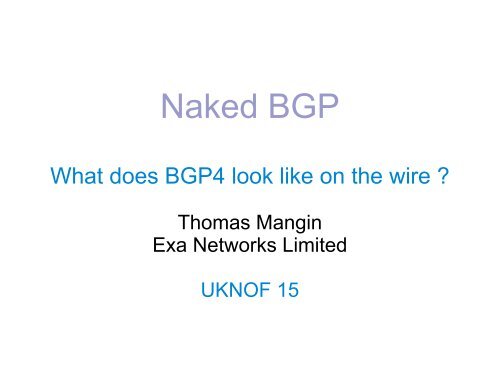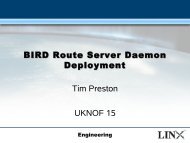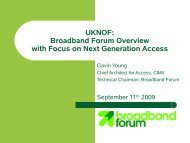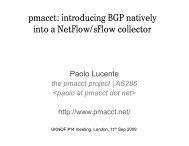Mangin - Naked BGP.pdf
Mangin - Naked BGP.pdf
Mangin - Naked BGP.pdf
You also want an ePaper? Increase the reach of your titles
YUMPU automatically turns print PDFs into web optimized ePapers that Google loves.
<strong>Naked</strong> <strong>BGP</strong><br />
What does <strong>BGP</strong>4 look like on the wire ?<br />
Thomas <strong>Mangin</strong><br />
Exa Networks Limited<br />
UKNOF 15
Who reads RFCs ?<br />
●<br />
●<br />
●<br />
●<br />
Desperate network engineers<br />
– why is that session « stuck in ACTIVE »<br />
– why are my routers now crashing (ASN4)<br />
Bleeding edge engineers<br />
– what is FlowSpec ?<br />
Curious Engineers<br />
– what if I changed the HoldTime value to 3 ??<br />
MAD people<br />
– wanting to write their own software ← I am here ..<br />
– mostly SIP developers nowdays
A new application why ?<br />
● Announce our service IP (/32)<br />
– SMTP, MX, POP, IMAP, WEBMAIL, AUTH DNS, ...<br />
● Others exist but ....<br />
– Open<strong>BGP</strong>D – great but no official support on Linux<br />
– BIRD – good but no package for all our Linux distros<br />
– Quagga – Cisco configuration format (pain)<br />
– bgpfeeder, bgpsimple, pybgp – no IPv6<br />
● Wanted ....<br />
– easy installation (python always installed, nothing else needed)<br />
– familiar and simple configuration<br />
– integrate with our code base (suspension, IWF filtering, etc.)
<strong>BGP</strong>4 – Main RFCs<br />
✔ RFC 4271<br />
– A Border Gateway Protocol 4 (<strong>BGP</strong>-4)<br />
– Obsoletes: 1771<br />
✔ RFC 5492<br />
– Capabilities Advertisement with <strong>BGP</strong>-4<br />
– Obsoletes: 3392, 2842<br />
✗<br />
RFC 2385<br />
– Protection of <strong>BGP</strong> Sessions via the TCP MD5 Signature<br />
I can't implement it, the Python socket module does not<br />
export TCP_MD5_AUTH
<strong>BGP</strong>4 – Common RFCs<br />
✗<br />
RFC 3107<br />
– Carrying Label Information in <strong>BGP</strong>-4<br />
✔ RFC 4760 (and RFC 2545)<br />
– Multiprotocol Extensions for <strong>BGP</strong>-4<br />
– Obsoletes: 2858<br />
✗<br />
RFC 4893<br />
– <strong>BGP</strong> Support for Four-octet AS Number Space
<strong>BGP</strong>4 – Less common RFCs<br />
✔ RFC 4724<br />
– Graceful Restart Mechanism for <strong>BGP</strong><br />
✗<br />
RFC 4360<br />
– <strong>BGP</strong> Extended Communities Attribute<br />
✗<br />
RFC 5575<br />
– Dissemination of Flow Specification Rules<br />
➔ Find all <strong>BGP</strong>-4 related RFCs<br />
– http://www.bgp4.as/rfc
Packets<br />
●<br />
Very few types<br />
● OPEN – to negociate a <strong>BGP</strong>4 connection<br />
●<br />
NOTIFICATION – to report issues to the peer<br />
● KEEPALIVE – to not wait for a TCP timeout<br />
● UPDATE – to exchange routes<br />
●<br />
More defined by other RFCs<br />
●<br />
●<br />
RFC 2918 – ROUTE REFRESH<br />
…
Steps of a <strong>BGP</strong> session<br />
Opening sequence of packets<br />
Configured but not ready<br />
Configured and ready<br />
TCP connection<br />
→ OPEN<br />
← OPEN<br />
← KEEPALIVE<br />
→ KEEPALIVE<br />
(IDLE)<br />
(ACTIVE)<br />
(CONNECT)<br />
(OPENSENT)<br />
(OPENCONFIRM)<br />
(ESTABLISHED)
Conversation<br />
exchange of routes (if needed)..<br />
→ UPDATE ?<br />
← UPDATE ?<br />
Routes are not re-sent if no change occurs<br />
(unless both routers support route refresh)<br />
And start to send each other messages to detect<br />
dead peers<br />
→ KEEPALIVE<br />
← KEEPALIVE
Message<br />
●<br />
●<br />
●<br />
Marker – 16 bytes<br />
● legacy header from RFC 1105<br />
●<br />
●<br />
●<br />
Marker (2 bytes), Length (2 bytes), version (1 byte)<br />
Type (1 byte), HoldTime (1 Byte)<br />
kept but blanked<br />
●<br />
0xFFFFFFFFFFFFFFFFFFFFFFFFFFFFFFFF<br />
Length of content – 1 short<br />
Type of Message – 1 byte<br />
● OPEN 0x01<br />
● UPDATE 0x02<br />
● NOTIFICATION 0x04<br />
● KEEPALIVE 0x08
OPEN<br />
● Version – 1 byte<br />
● ASN – 1 short<br />
● HoldTime – 1 short<br />
● <strong>BGP</strong> Identifier – 4 bytes<br />
●<br />
Optional Parameter Length – 1 Byte<br />
● Optional Parameters – LEN bytes<br />
– initially for optional authentification (deprecated)<br />
– now for capabilities allowing protocol extension
OPEN<br />
●<br />
●<br />
HOLDTIME<br />
– hearbeat interval<br />
– negotiated as the lower holdtime between both OPEN<br />
●<br />
You can cause lots of <strong>BGP</strong> traffic forcing a low value<br />
– default depends on vendor<br />
● Juniper 90<br />
● Cisco 180<br />
– can not be lower than 3 (as KeepAlive is HoldTime / 3)<br />
– connection MAY be rejected based on KEEPALIVE value<br />
<strong>BGP</strong> IDENTIFIER<br />
– unique 32 bit number<br />
●<br />
not really an IP but set to the IP used for the connection (in IPv4)<br />
– often called Router-ID<br />
– used to know which connection the router must keep
CAPABILITIES<br />
●<br />
●<br />
●<br />
Unknown capabilities received are ignored<br />
A capability can be sent multiple times with<br />
different values<br />
– For example to indicate support for multiple protocols<br />
Capabilities Format<br />
● Code 1 byte<br />
● Length 1 byte<br />
● Value LEN byte(s)
CAPABILITIES<br />
●<br />
http://www.iana.org/assignments/capability-codes/<br />
● RESERVED 0x00<br />
● MULTIPROTOCOL_EXTENSIONS 0x01 [RFC2858]<br />
● ROUTE_REFRESH 0x02 [RFC2918]<br />
● OUTBOUND_ROUTE_FILTERING 0x03 [RFC5291]<br />
● MULTIPLE_ROUTES 0x04 [RFC3107]<br />
● EXTENDED_NEXT_HOP 0x05 [RFC5549]<br />
● Unassigned 0x06 - 0x3F (63)<br />
● GRACEFUL_RESTART 0x40 [RFC4724]<br />
● FOUR_BYTES_ASN 0x41 [RFC4893]<br />
● Deprecated 0x42 (66)<br />
● DYNAMIC_CAPABILITY 0x43 [Chen]<br />
● MULTISESSION_<strong>BGP</strong> 0x44 [Appanna]<br />
● ADD_PATH 0x45 [draft-ietf-idr-add-paths]<br />
● Unassigned 0x46 (70) - 0x7F (127)<br />
● Reserved for Private Use 0x80 (128) – 0xFF (255) [RFC5492]<br />
● CISCO_ROUTE_REFRESH 0x80<br />
– Can only find reference to this in the router logs
CAPABILITIES<br />
●<br />
●<br />
AFI - Address Family Identifiers<br />
● http://www.iana.org/assignments/address-family-numbers/<br />
● IPv4 – 0x01<br />
● IPv6 – 0x02<br />
SAFI - Subsequent AFI<br />
● http://www.iana.org/assignments/safi-namespace<br />
● SAFI Unicast – 0x01<br />
● SAFI Multicast – 0x02<br />
● MPLS-labeled VPN address – 0x80
CAPABILITIES<br />
●<br />
Multiprotocol extension<br />
●<br />
●<br />
●<br />
OPEN with family (AFI/SAFI) of extra protocols supported<br />
– one capability per pair supported<br />
http://www.iana.org/assignments/address-family-numbers/<br />
http://www.iana.org/assignments/safi-namespace<br />
●<br />
Graceful Restart<br />
●<br />
●<br />
let the speaker know<br />
– if the session is from a restart<br />
– how long to wait before dropping stale routes<br />
AFI/SAFI for which GR is supported
OPEN parsed<br />
OPEN Message<br />
Marker: 16 bytes<br />
Length: 45 bytes<br />
Type: OPEN Message (1)<br />
Version: 4<br />
My AS: 100<br />
Hold time: 180<br />
<strong>BGP</strong> identifier: 1.1.1.1<br />
Optional parameters length: 16 bytes<br />
Optional parameters<br />
Capabilities Advertisement (8 bytes)<br />
Parameter type: Capabilities (2)<br />
Parameter length: 6 bytes<br />
Multiprotocol extensions capability (6 bytes)<br />
Capability code: Multiprotocol extensions capability (1)<br />
Capability length: 4 bytes<br />
Capability value<br />
Address family identifier: IPv4 (1)<br />
Reserved: 1 byte<br />
Subsequent address family identifier: Unicast (1)<br />
Capabilities Advertisement (4 bytes)<br />
Parameter type: Capabilities (2)<br />
Parameter length: 2 bytes<br />
Route refresh capability (2 bytes)<br />
Capability code: Route refresh capability (128)<br />
Capability length: 0 bytes<br />
Capabilities Advertisement (4 bytes)<br />
Parameter type: Capabilities (2)<br />
Parameter length: 2 bytes<br />
Route refresh capability (2 bytes)<br />
Capability code: Route refresh capability (2)<br />
Capability length: 0 bytes
NOTIFICATION<br />
●<br />
●<br />
●<br />
●<br />
Format<br />
Error codes<br />
● Error code 1 byte<br />
● Error subcode 1 byte<br />
● Data variable<br />
1 – Message header error 4 – Hold timer expired<br />
2 – OPEN message error 5 – State machine error<br />
3 – UPDATE message error 6 – Cease<br />
Error Sub Code<br />
● too many to list, see RFC 4271 section 4.5<br />
Data is a human readeable string<br />
●<br />
its length is calculated from the length of the message
KEEPALIVE<br />
●<br />
●<br />
●<br />
No content, just the <strong>BGP</strong> Header<br />
Heartbeat message<br />
If no message is seen during a HoldTime<br />
period, the session must be torn down<br />
● KeepAliveTime = HoldTime / 3<br />
● « a reasonable maximum time »<br />
● « no more than once a second »<br />
●<br />
KEEPALIVE message should be sent every<br />
KeepAlive time if no UPDATE was generated to<br />
make sure no Timeout occurs
UPDATE<br />
●<br />
●<br />
Used to update remote RIB<br />
For IPv4 Nice and simple<br />
●<br />
●<br />
●<br />
routes to remove (in NLRI format)<br />
characteristics of the new routes<br />
new routes (in NLRI format)<br />
● Format<br />
● Withdrawn Routes Length 2 bytes<br />
● Withdrawn Routes LEN above bytes<br />
● Total Path Attribute Length 2 bytes<br />
● Path Attributes LEN above bytes<br />
● NLRI(s) what is left<br />
●<br />
Space efficient<br />
● Maximum message size is 4096
NLRI<br />
●<br />
Network Layer Reachability Information<br />
●<br />
Fancy RFC name for a prefix<br />
● Netmask as a character => /32 byte of value 32<br />
●<br />
Followed by only the necessary bytes of the IP address<br />
●<br />
Examples<br />
● 10.0.0.0/8 0x08 0x10<br />
● 192.0.2.0/24 0x18 0xC0 0x00 0x02<br />
● 192.0.2.1/29 0x1D 0xC0 0x00 0x02 0x01<br />
● 0.0.0.0/0 0x00
Path Attributes<br />
●<br />
●<br />
Store routes meta-data<br />
– Transitive : Router must relay the Attribute<br />
●<br />
●<br />
Unknown Transitive SHOULD be accepted<br />
Unknown non-transitive MUST be ignored<br />
– Optional : Understanding of this attribute is optional<br />
– Mandatory : Must be present (or Discretionary)<br />
● Well known MUST be transitive<br />
● MUST be supported by every implementation<br />
– Partial : Do we know this attribute<br />
●<br />
Once set as unknown the value stays set<br />
– Every route in the path can add some optional transitive attribute<br />
Well Known Attributes (minimum implementation)<br />
– Mandatory ORIGIN, AS_PATH, NEXT_HOP<br />
– Discretionary LOCAL_PREF, ATOMIC_AGGREGATE
Path Attributes<br />
●<br />
Best known attributes<br />
●<br />
CODE NAME FLAGS Number Other<br />
●<br />
0x01 ORIGIN Mandatory, Transitive Unique<br />
●<br />
0x02 AS-PATH Mandatory, Transitive Unique<br />
●<br />
0x03 NEXT_HOP Mandatory, Transitive Unique<br />
●<br />
0x04 MED Optional Unique E<strong>BGP</strong> only<br />
●<br />
0x05 LOCALPREF Discretionary,Transitive Unique I<strong>BGP</strong> only<br />
●<br />
0x06 ATOMIC_AGGREGATE Discretionary, Transitive<br />
●<br />
0x07 AGGREGATOR Optional Unique<br />
●<br />
0x08 COMMUNITIES Optional,Transitive Unique<br />
●<br />
0x09 ORGINATOR_ID, 0x0A CLUSTER_LIST<br />
●<br />
0x0E MP REACH NLRI Optional,Transitive Multiple<br />
●<br />
0x0F MP UNREACH NLRI Optional,Transitive Multiple<br />
●<br />
Selection Algorithm order<br />
●<br />
highest LOCAL_PREF – shorter AS_PATH – lower ORIGIN – lowest MED – E<strong>BGP</strong> over I<strong>BGP</strong>
Path Attributes<br />
● Attribute Flag 1 byte<br />
●<br />
Flags description<br />
●<br />
– 0x10 EXTENDED_LENGTH The length is two bytes and not one<br />
– 0x20 PARTIAL do we understand what is relaid<br />
– 0x40 TRANSITIVE order to pass the attribute even if non known<br />
– 0x80 OPTIONAL zero for Well Known Attributes<br />
Sum of all the flags (some would say binary OR)<br />
● Attribute Code 1 byte<br />
● Length 1 byte or 1 short<br />
● Attribute Value LEN Above<br />
●<br />
content of the Attribute dependant on the attribute code
ORIGIN<br />
●<br />
Attribute Value<br />
●<br />
1 byte with the origin<br />
– 0x00 IGP<br />
Network Layer Reachability Information is interior to the<br />
originating AS<br />
– 0x01 EGP<br />
Network Layer Reachability Information learned via the<br />
EGP protocol [RFC904]<br />
– 0x02 INCOMPLETE<br />
Network Layer Reachability Information learned by some<br />
other means
AS_PATH<br />
●<br />
Attribute Value<br />
●<br />
Sequence of one or multiple path segments<br />
– path segment type 1 byte<br />
● 0x01 AS_SET<br />
– unordered set of ASes<br />
– Included when performing an aggregation<br />
● 0x02 AS_SEQUENCE<br />
– ordered set of ASes<br />
– Used path the path vector algorithm<br />
– path segment length 1 byte<br />
– length, path segment value ABOVE LEN * 2 byte(s)<br />
●<br />
list of short integer
NEXT_HOP<br />
●<br />
Attribute Value<br />
– IP 4 bytes<br />
●<br />
inet_aton representation of the Ipv4<br />
●<br />
Well Known Attribute<br />
– in RFC 4271<br />
●<br />
Does not always need to be present<br />
– in RFC 4760
LOCAL_PREF, MED, ...<br />
●<br />
Attribute Value<br />
● long integer 4 bytes<br />
● The other Attributes are waiting for you in RFC 4271
UPDATE parsed<br />
UPDATE Message (I removed a MED attribute and removed a route to fit the slide so the sizes are off)<br />
Marker: 16 bytes<br />
Length: 52 bytes<br />
Type: UPDATE Message (2)<br />
Unfeasible routes length: 0 bytes<br />
Total path attribute length: 25 bytes<br />
Path attributes<br />
ORIGIN: IGP (4 bytes)<br />
Flags: 0x40 (Well-known, Transitive, Complete)<br />
0... .... = Well-known<br />
.1.. .... = Transitive<br />
..0. .... = Complete<br />
...0 .... = Regular length<br />
Type code: ORIGIN (1)<br />
Length: 1 byte<br />
Origin: IGP (0)<br />
AS_PATH: 100 (7 bytes)<br />
Flags: 0x40 (Well-known, Transitive, Complete)<br />
0... .... = Well-known<br />
.1.. .... = Transitive<br />
..0. .... = Complete<br />
...0 .... = Regular length<br />
Type code: AS_PATH (2)<br />
Length: 4 bytes<br />
AS path: 100<br />
AS path segment: 100<br />
Path segment type: AS_SEQUENCE (2)<br />
Path segment length: 1 AS<br />
Path segment value: 100<br />
NEXT_HOP: 10.0.0.1 (7 bytes)<br />
Flags: 0x40 (Well-known, Transitive, Complete)<br />
0... .... = Well-known<br />
.1.. .... = Transitive<br />
..0. .... = Complete<br />
...0 .... = Regular length<br />
Type code: NEXT_HOP (3)<br />
Length: 4 bytes<br />
Next hop: 10.0.0.1 (10.0.0.1)<br />
Network layer reachability information: 4 bytes<br />
50.0.0.0/24<br />
NLRI prefix length: 24<br />
NLRI prefix: 50.0.0.0 (50.0.0.0)
Path Attribute and IPv6<br />
●<br />
●<br />
Announcing an IPv6 route<br />
●<br />
●<br />
The AFI/SAFI family pair must have been received<br />
in the OPEN CAPABILITY<br />
Special case of MultiProcol <strong>BGP</strong><br />
– Create a UPDATE<br />
●<br />
●<br />
●<br />
●<br />
●<br />
with no withdrawal<br />
with no NLRI<br />
with an ORIGIN and AS_PATH (NEXT_HOP ignored)<br />
If any, one MP UNREACH NLRI with all the routes to remove<br />
If any, one MP REACH NRI with all the routes to add<br />
– Only takes a few bytes more to use MP <strong>BGP</strong> for IPv4<br />
MP <strong>BGP</strong> is an elegant solution to avoid <strong>BGP</strong>5
MP_UNREACH_NLRI<br />
●<br />
Format<br />
– AFI 2 bytes<br />
– SAFI 1 byte<br />
– Withdrawn NLRIs remaining data<br />
●<br />
●<br />
To send IPv6 routes<br />
●<br />
The AFI/SAFI family pair must have been received<br />
in the OPEN CAPABILITY<br />
Could be used to send IPv4 routes as well<br />
●<br />
Most routers do not announce IPv4<br />
Unicast/Multicast in their OPEN
MP_REACH_NLRI<br />
●<br />
Format<br />
– AFI 2 bytes<br />
– SAFI 1 byte<br />
– Length of Next HOP 1 byte<br />
– Next HOP ABOVE LEN<br />
– Reserved (must be zero) 1 byte<br />
– List of NLRIs remaining data<br />
●<br />
IPv6 has 3 unicast address scope<br />
– Global well suited for routing<br />
– Site-local <strong>BGP</strong> has no concept of site and can not use it<br />
– Link-local only relevant for both BPG speakers<br />
●<br />
IPv6 Next HOP<br />
– next-hop size can be 16 or 32 (one or two IPs)<br />
– global IP is required<br />
– Link-local<br />
● may be included<br />
●<br />
may be remove by the receiving router
Graceful Restart<br />
●<br />
●<br />
●<br />
A Change to the forwarding<br />
– keep routes in RIB<br />
●<br />
●<br />
when <strong>BGP</strong> connection is lost<br />
If an new OPEN negotiation start even if nothing wrong detected<br />
End-of-RIB Marker<br />
– is a valid UPDATE for the AFI/SAFI family<br />
●<br />
●<br />
●<br />
with no reachable NLRI<br />
with empty withdrawn NLRI<br />
with no Path Attribute<br />
– inform that all the routes have been (re)transmitted<br />
Often implemented even if hardware can not retain routes<br />
on reboot for faster route selection
Graceful Restart<br />
●<br />
Capability<br />
●<br />
●<br />
●<br />
●<br />
Restart Flag<br />
– indicate we are recovering from a failure<br />
– prevent deadlock caused by waiting for the EOR marker when<br />
multiple <strong>BGP</strong> speakers peering with each other restart<br />
Restart Time<br />
– estimated time to re-establish the connection<br />
– prevent waiting for a dead peer<br />
The AFI/SAFI for which GR is supported<br />
Address Family Flag<br />
– let the router know if forwarding was well maintained during<br />
reboot
Graceful Restart<br />
●<br />
●<br />
Allow hitless switch of <strong>BGP</strong> process<br />
– switch master to backup RE and back<br />
– the router must still route during the <strong>BGP</strong> restart<br />
Peer announced Graceful Restart<br />
●<br />
●<br />
connection is detected as failed<br />
– no end notification was sent<br />
the router does NOT remove the <strong>BGP</strong> routes<br />
– mark them as stale but keep using them<br />
– wait for the time specified in the OPEN capability<br />
– if no changes, remove the route
RFC 5575 / Flow Spec<br />
● What is RFC 5575 ?<br />
– previously known as « flow spec » before August 2009<br />
– supported by Juniper (no idea about Cisco)<br />
– drafts by Juniper, Abor and NTT<br />
● 2 of the 4 Juniper engineers have Cisco emails in the RFC :)<br />
● What is a « flow » ?<br />
● new NLRI (like IPv6, MPLS, VPLS, …)<br />
– but not a « route » more a firewall match condition<br />
– AFI 1, SAFI 133 for internet trafic<br />
– AFI 1, SAFI 134 for MPLS traffic<br />
– validated against corresponding unicast routing table<br />
● build with « components »<br />
● Why use it ?<br />
●<br />
●<br />
●<br />
handle DDOS with ASIC accelerated routers<br />
throttle protocols<br />
redirect selected type of traffic
RFC 5575 / Flow Spec<br />
●<br />
●<br />
Possible components making the flow<br />
●<br />
●<br />
●<br />
●<br />
●<br />
●<br />
●<br />
●<br />
Prefix (source and destination)<br />
IP Protocol (list of )<br />
– end of list, AND, LEN, less than, more than, equal<br />
– allow to express a port range, ie > 6880 and < 6890<br />
Port (source, destination, either)<br />
ICMP (type, code)<br />
TCP flag (list of )<br />
– end of list, AND, LEN, NOT, match (set or unset)<br />
Packet Len<br />
DSCP<br />
Fragment<br />
– Don't Fragment, Is Fragment, First Fragment, Last Fragment<br />
Format<br />
●<br />
the RFC includes some example packets<br />
●<br />
and how to decode them in the RFC :D
RFC 5575 / Flow Spec<br />
●<br />
Filtering actions<br />
●<br />
Use communities (your network, your choice)<br />
– Normal or extended<br />
– No convention but a small set of extended communities<br />
●<br />
See RFC 4360 …<br />
– 0x8006 traffic-rate 2-byte as#, 4-byte float<br />
– 0x8007 traffic-action bitmask<br />
● 0x47 Terminal Filtering Action<br />
● 0x46 Sample and Log for this NLRI<br />
– 0x45-0x00 Reserved / Undefined<br />
– 0x8008 redirect 6-byte Route Target<br />
– 0x8009 traffic-marking DSCP value
Variation between vendors<br />
●<br />
●<br />
●<br />
Pretty clear and well followed RFC<br />
– make reading SIP RFC painful<br />
– no major variation noted<br />
Malformed Packets<br />
– Quagga and Cisco accept wrong Attribute Flag for Well<br />
Known Attributes (like with wrong Transitivity)<br />
– Juniper refuse and send you some obscure<br />
NOTIFICATION (my fault in the first instance)<br />
Not many differences<br />
– CISCO_ROUTE_REFRESH and ROUTE_REFRESH<br />
– Cisco extra KEEPALIVE as EOR
Extra KEEPALIVE<br />
●<br />
●<br />
Sequence of messages<br />
→ OPEN<br />
← OPEN<br />
← KEEPALIVE<br />
→ KEEPALIVE (end of OPEN sequence)<br />
← KEEPALIVE (as no update / EOR ?)<br />
← KEEPALIVE (used as EOR / Normal KA ?)<br />
Normal usage of KEEPALIVE<br />
Not in any RFC
<strong>BGP</strong> route injector<br />
●<br />
●<br />
●<br />
Usage<br />
●<br />
initially for ASN 112 annoucement<br />
● now to announce all customer facing IPs (/32)<br />
●<br />
– for both IPv4 and IPv6<br />
Replaced some LVS and Wackamole<br />
Graceful Restart allows for<br />
– for service on one machine only<br />
●<br />
●<br />
restart the daemon without flap on config change<br />
reboot machine without causing any routing change<br />
A low hold-time allows to:<br />
– rapid fail-over to a active backup machine
<strong>BGP</strong> route injector<br />
●<br />
Juniper do not like gratuitous ARP<br />
– disabling it is a security risk<br />
– behaviour may only be changed per interface, not VLAN<br />
– causes issues with most failover systems client side<br />
– not able to announce /32 or /128 using ARP broadcast<br />
●<br />
Exa Networks' <strong>BGP</strong> route injector<br />
– http://bgp.exa.org.uk/<br />
– Juniper like syntax
Example – ASN 112<br />
neighbor 192.0.2.254 {<br />
description "a core bgp router";<br />
router-id 192.175.48.254;<br />
local-address 10.0.0.254;<br />
local-as 112;<br />
peer-as 64511;<br />
hold-time 30;<br />
graceful-restart 300;<br />
}<br />
static {<br />
route 192.175.48.0/25 {<br />
next-hop 192.0.2.1;<br />
med 100;<br />
community [ 64511:30740 64511:0 ];<br />
}<br />
route 192.175.48.128/25 next-hop 192.0.2.2 community 0x101;<br />
}
The program itself<br />
●<br />
●<br />
●<br />
●<br />
●<br />
No dependencies<br />
No need to run as root (does not bind)<br />
Single threaded with co-routine<br />
Recommend the issue of daemontools for<br />
supervision<br />
In production in our network for a few months
QUESTIONS ??<br />
Answers :<br />
●<br />
Why is a router stuck in active ?<br />
●<br />
it could not establish a connection to its peer<br />
●<br />
it is not trying anymore (configuration, algo choice, ...)<br />
●<br />
your peer is not trying neither<br />
●<br />
forcing the peer to return to IDLE state will force a new attempt to connect<br />
●<br />
Why is my router crashing<br />
●<br />
The answer is at http://www.andyd.net/media/talks/asn4_breaks_network.<strong>pdf</strong><br />
●<br />
What is flow spec<br />
●<br />
Now you know !<br />
●<br />
What if I use a Holdtime of 3<br />
●<br />
Lots of KEEPALIVE packets being exchanged<br />
●<br />
The fastest possible detection of peer failure without BFD
BLOOPERS<br />
Mandriva fun ...<br />
# urpmi bird<br />
To satisfy dependencies, the following packages are going to be installed:<br />
Package<br />
(medium "contrib")<br />
Version Release Arch<br />
libquagga0<br />
quagga<br />
0.99.7<br />
0.99.7<br />
2mdv2008.0<br />
2mdv2008.0<br />
i586<br />
i586<br />
3.7MB of additional disk space will be used.<br />
Proceed with the installation of the 2 packages? (Y/n) n













